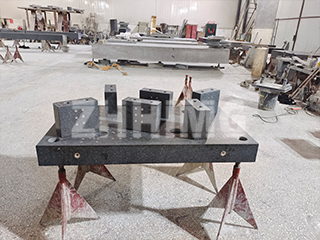For professionals in machinery manufacturing, electronics production, and precision engineering, a reliable reference surface is the cornerstone of accurate measurements and quality control. Granite inspection platforms stand out as indispensable tools in these fields, offering unparalleled stability, wear resistance, and precision. Whether you’re calibrating machine parts, conducting dimensional checks, or creating precise layouts, understanding the functionality and quality standards of granite inspection platforms is crucial. Below is a detailed breakdown to help you make informed decisions and optimize your workflow.
1. What Are Granite Inspection Platforms Used For?
Granite inspection platforms are engineered to serve as high-precision reference surfaces across multiple industries. Their exceptional rigidity and resistance to environmental factors (such as temperature changes and corrosion) make them ideal for a wide range of applications:
- Precision Measurement & Calibration: Acting as a stable base for testing the flatness, parallelism, and straightness of mechanical components. They ensure accurate readings when using tools like dial indicators, height gauges, and coordinate measuring machines (CMMs).
- Workpiece Positioning & Assembly: Providing a consistent surface for aligning, assembling, and marking parts during manufacturing processes. This reduces errors and improves the overall quality of finished products.
- Welding & Fabrication: Serving as a durable workbench for welding small to medium-sized components, ensuring that joints are aligned correctly and meet design specifications.
- Dynamic Performance Testing: Supporting mechanical tests that require a vibration-free surface, such as load testing or fatigue analysis of parts.
- General Industrial Applications: Used in over 20 industries, including machinery manufacturing, electronics production, automotive, aerospace, and mold making. They are essential for tasks like precision scribing, grinding, and quality inspection of both standard and high-precision parts.
2. How to Evaluate the Quality of Granite Inspection Platforms?
The quality of a granite inspection platform directly impacts its performance and longevity. Key quality checks focus on surface quality, material properties, and precision levels. Here’s a step-by-step guide to assessing these factors:
2.1 Surface Quality Inspection
The surface of a granite inspection platform must meet strict standards to ensure accuracy. The number of contact points (measured in a 25mm x 25mm square area) is a critical indicator of surface flatness, and it varies by precision grade:
- Grade 0: Minimum 25 contact points per 25mm² (highest precision, suitable for laboratory calibration and ultra-precision measurements).
- Grade 1: Minimum 25 contact points per 25mm² (ideal for high-precision manufacturing and quality control).
- Grade 2: Minimum 20 contact points per 25mm² (used for general precision tasks like part inspection and assembly).
- Grade 3: Minimum 12 contact points per 25mm² (suitable for basic applications such as rough marking and low-precision assembly).
All grades must comply with national and international metrology standards (e.g., ISO, DIN, or ANSI) to ensure consistency and reliability.
2.2 Material & Structural Quality
High-quality granite inspection platforms are crafted from premium materials to enhance durability and stability:
- Material Selection: Typically made from fine-grained gray cast iron or alloy cast iron (some high-end models use natural granite for superior vibration damping). The material should have a uniform structure to avoid internal stresses that could affect flatness over time.
- Hardness Requirement: The working surface must have a hardness of 170–220 HB (Brinell Hardness). This ensures resistance to scratches, wear, and deformation, even under heavy loads or frequent use.
- Customizable Features: Many platforms can be customized with V-grooves, T-slots, U-slots, or holes (including long holes) to accommodate specific tools or workpieces. These features should be machined with high precision to maintain the platform’s overall accuracy.
3. Why Choose Our Granite Inspection Platforms?
At ZHHIMG, we prioritize quality, precision, and customer satisfaction. Our granite inspection platforms are designed to meet the diverse needs of modern industries, offering:
- Superior Precision: All platforms are manufactured to Grade 0–3 standards, with strict quality control at every stage of production.
- Durable Materials: We use high-quality cast iron and natural granite (optional) to ensure long-term performance and resistance to wear.
- Customization Options: Tailor your platform with grooves, holes, or specific dimensions to fit your unique workflow requirements.
- Global Compliance: Our products adhere to international standards, making them suitable for use in markets worldwide.
Whether you’re looking to upgrade your quality control process, improve manufacturing accuracy, or streamline your assembly line, our granite inspection platforms are the reliable choice.
Ready to Enhance Your Precision Workflow?
If you want to learn more about how our granite inspection platforms can benefit your business, or if you need a customized solution, contact our team today. Our experts will provide personalized advice and a detailed quote to meet your specific needs. Don’t compromise on precision—choose ZHHIMG for high-quality inspection tools that drive results.
Post time: Aug-27-2025

